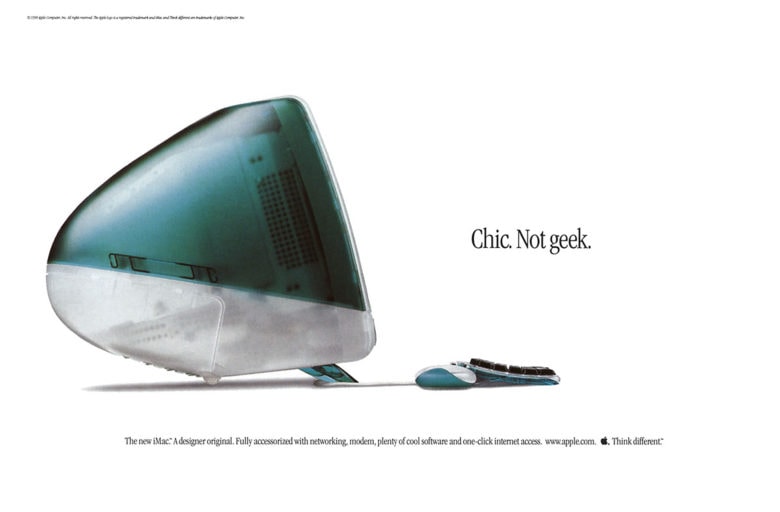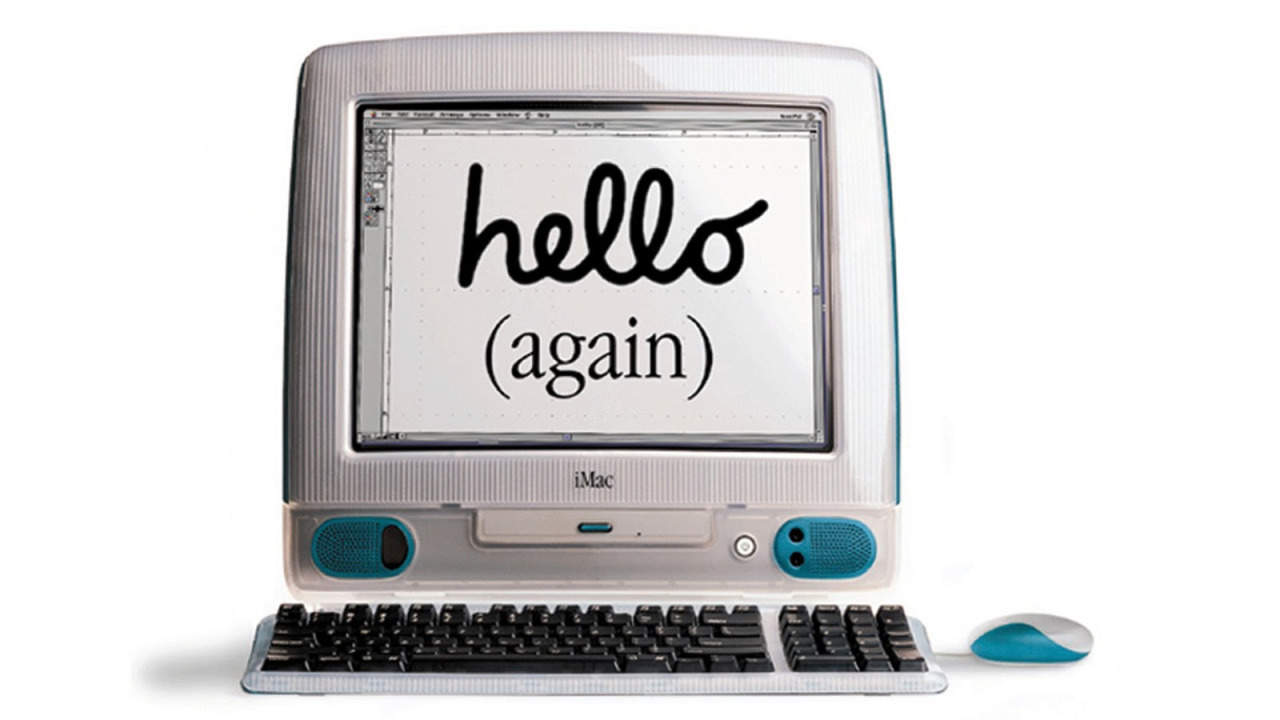 August 15, 1998: The original iMac — Apple’s brightly colored, translucent Macintosh relaunch — goes on sale to a rabid audience. Apple co-founder Steve Jobs‘ first major new product since returning to Cupertino, the internet-ready iMac G3 line will cement his legacy as a forward-thinking tech visionary.
August 15, 1998: The original iMac — Apple’s brightly colored, translucent Macintosh relaunch — goes on sale to a rabid audience. Apple co-founder Steve Jobs‘ first major new product since returning to Cupertino, the internet-ready iMac G3 line will cement his legacy as a forward-thinking tech visionary.
The all-in-one computer also introduces the world to the design talents of Jony Ive — and pretty much saves Apple in the process.
Just another day at the office, eh?
iMac G3: Computer ‘from another planet’
In a sea of beige boxes, the colorful iMac cut a figure like no other computer.
“It looks like it’s from another planet,” Jobs said at the time. “A good planet. A planet with better designers.”
That designer was, of course, Jony Ive. He had worked at Apple for a few years by this point (one of his earliest projects was the Newton MessagePad product line). But the iMac G3 represented the purest expression of his creativity yet. The iMac also effectively formed a bond between Jobs and Ive that lasted until the Apple CEO’s death in 2011.
The iMac G3 initially came in a kind of sea green that Apple dubbed “Bondi Blue” (named after the water at an Australian beach). The product line later expanded to include a broad range of colors and patterns.
Its translucent, plasticized design always struck me as both slightly retro and incredibly futuristic. The conflation made perfect sense in a decade like the ’90s, as people waxed nostalgic for the 1960s but looked forward to the new millennium.
The iMac: Tailor-made for the internet

Image: Apple
In terms of specs, the original iMac boasted a 233 MHz PowerPC 750 (G3) processor, 32MB of RAM, a 4GB EIDE hard drive, and a choice of either ATI Rage IIc graphics with 2MB of VRAM or ATI Rage Pro Turbo graphics with 6MB of VRAM.
Technologically, this wasn’t a massive upgrade from what Apple had done in the past, or what other companies were doing at the time. The big difference with the iMac — appearance aside — was that it was designed to be an internet computer.
The iMac came with a built-in telephone modem at a time when most computers included them only as optional extras. It also promised customers access to the World Wide Web within minutes of first switching on their new computer.
Apple received 150,000 orders for the iMac prior to its launch. The promise of the computer drove Apple’s stock price above $40 a share — its highest mark in three years. The iMac G3 also benefited from a healthy advertising budget of $100 million. The company’s PR department told people it would be the biggest computer launch in Apple’s history.
Early iMac G3 reviews missed the boat
Considering how fondly remembered the machine is today, and what an important turning point it represented for Apple, one of the most surprising things about the first iMac is that it received plenty of negative reviews when it first came out.
“The iMac will only sell to some of the true believers,” said a face-palming review in The Boston Globe. “The iMac doesn’t include a floppy disk for doing file backups or sharing of data. It’s an astonishing lapse from Jobs, who should have learned better…. The iMac is clean, elegant, floppy-free — and doomed.”
Other reviews complained about the lack of Windows compatibility (and therefore a possible lack of software). And many noted the iMac’s relatively high price point, even though the new machine cost considerably less than many previous Apple computers. (It retailed for $1,299, or more than $2,500 in today’s money.)
The most legitimate critique of the computer was its terrible “hockey puck” mouse, which illustrated perfectly what happened when form won over function in Apple’s design studio.
Still, the machine became an enormous success. Apple soon borrowed its winning design language and internet focus to create the new clamshell iBook laptop.
Did you own an iMac G3? More than two decades later, what are your thoughts and memories of one of Apple’s most iconic computers? Leave your comments below.



7 responses to “Today in Apple history: Original iMac arrives to save Apple”
A great thing about the 1998 presentation is the historical perspective.
I’ve enjoyed your contributions to these articles. When, out of interest, was your intro to computers (and Apple in particular)? Also — the best thing about the iMac launch video was Schiller’s tremendous mullet.
Luke, I seriously got into computers in 1991. I did HND Manufacturing Engineering at Salford Tech. and learned C Programming in the Sun suite, which was a room full of brand new terminals running Sun Unix-based ‘Open Windows’, with high-tech desking and chairs, futuristic mice with a red light underneath reflected back off a metallic mousepad. That was really great. We also learned AutoCAD 10 for DOS and used other DOS programs WordPerfect and Harvard Graphics. I bought my first PC then, a 486-DX2 66Mhz etc. LOL, with MS-DOS 5.1 and soon got a copy of MS Windows 3.1, which was not so great as you know. I heard all about Macs and MacOS but they were out of reach then and it was impossible to install Apple’s OS on PC hardware. I imagined it would be more comparable to Sun’s futuristic Open Windows than to MS Windows and always kept it in mind. I even tinkered with Apple emulators Sheepshaver and Basilisk but it wasn’t so great. When Apple moved to Intel that opened the door and eventually bought an iMac in 2012 after testing and falling in love with MacOS on hackintosh. Yes, Schiller’s mullet was good, not quite on the level of footballer-clone ‘waterfall’ mullets some people wore around 1986/7 though LOL.
I remember being in the midnight lineup and (as a longtime Mac devotee) thinking, “Wow! A lineup for an Apple product!” Even at the time, it felt like an unmistakeable turning point. I loved my old Bondi blue beauty.
(I note that you edited “rapid audience” to “rabid audience” in the first sentence to the article. I believe the phrase you’re going for is “rapt audience.”)
I meant rabid audience (meaning, frothing-at-the-mouth enthusiastic), but rapt would have been as good or better. Alas, I was not rapid (or rapt or rabid) enough to stop you seeing my typo. :D
As a Mac collector, I have three of these Bondi Blue babies holding up the coffee table top in my family room. On top sits the original Mac. Just to be fair, the mouse on the iMac sucked big time.
Not even close to “sea green” but aqua.
The original iMac was a big deal for everyone. With Jobs’ return suddenly Apple was in the business of marketing once again. When the iMac spots showed up they played directly on the voiceover of the Think Different spots – people either loved it or hated it, but they could not ignore it.
Apple promoted it as a “two steps” Internet computer (according to the commercial,”there is no step three”) whereas in fact, a person still had to sign up for a provider, then laboriously enter stuff in the fields. (I met one customer who angrily returned the machine because it didn’t magically get on the net by just plugging it into a phone jack).
The first thing many users did was to get an external ZIP drive. Within a month or so, drives that matched the iMac looks were on the shelves, as were more traditional mice with the new plastics.
This machine had a huge impact on the industry. Timex put out an alarm clock that looked exactly like it. Just about everyone imitated the translucent white and Bondi plastics – even with such things as travel irons. Within a year, even clunky gray or putty-colored PC boxes sported crappy looking translucent colored plastics bolted to the flat fronts of their machines.
As for the Windows compatibility thing, there wasn’t any hue and cry about it – no more than for any preceding Mac. This remained as it had been for years. The existing, ultra-slow emulators and file conversion titles were on the shelves as before.
As for making an impact on the computer industry, the original iMac had more of an impact than the original 128K, largely because by the early nineties computer commercials had begun to flood the airwaves (they even had regularly running ads for Zip drives). People still watched the three networks and they didn’t have devices for skipping commercials, so they were seeing at least 20 computer-related commercials every evening. Apple put the iMac spots into heavy rotation, so that you would see it at least twice a night. In fact, every iMac commercial up through the gray versions had a huge impact. The original commercial (slow-spin-and-track over a white background) was a real head-turner. The “colors” ad the following year (with the five versions arranged like a spinning daisy) was also a big deal.
“Think different” brought Apple back into the public eye. The iMac commercials brought people back to the stores and the iMac saved Apple.